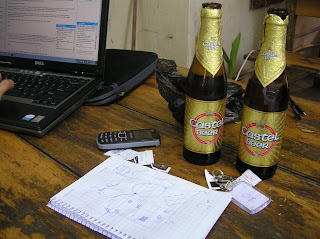Hey everybody!
In case you didn't notice the name, this blog is going to document the work and adventures of a team of archaeology students in Mali, West Africa. Kirsten Forsberg, who graduated from Yale University last May, received a Parker Huang Travel Fellowship to do archaeological research and survey in the area of Djenne, a city on the Bani River northeast of Bamako, Mali's capital city (see map).
Accompanying Kirsten are Wade Campbell, another recent graduate of Yale, and Helen McCreary, a current junior. Kirsten and Wade have been to Mali before, when they worked on Douglas Park's excavations at Tombouze, near Timbuktu.
So, what the heck are we going to be doing? Haha, good question. We have many plans. Will they all be successful? Who knows? Here's a basic list of what we'll probably be doing.
1. Survey in the desert to the east of Djenne and Jenne-Jeno (the ancient site a mile outside of the modern city, which is the site on which our professor, Rod McIntosh, wrote his dissertation). Survey means, in a nutshell, exploring an area extensively and systematically, using various methods to find and record the locations and types of new sites that could be investigated in the future.
2. Observation of preservation work done on the main site of Jenne-Jeno. The annual floods in the area have caused major erosion damage, and measures have been taken to curb the destruction of this UNESCO World Heritage Site.
3. Working with the Mission Culturelle de Djenne on their ongoing projects. This includes possible curation and maintenance of a new museum for the city.
In late November or early December, we will be leaving Djenne and traveling north to the Gorbi Valley, in the Lakes Region a few hours up the Niger River from Timbuktu (near Goundam, on the map above). There, we will be working for a month and a half on the excavations of Peter Coutros, a second-year PhD student at Yale. Several others will be joining us there, including Doug Park, who received his PhD in Archaeology from Yale last May, Jamie Inwood, another second-year PhD student, and Rod McIntosh, our professor and advisor, who is one of the founding fathers of West African archaeology. We're all going to be camping out in tents in the Sahara desert - it's gonna be quite a party :)
For the past several weeks, we have been planning and preparing in New Haven, CT. It's been an interesting process - many people to email, many supplies to get, many transportation and housing plans to be made. We're getting close! We were originally slated to ship out the morning of September 18, this Sunday. But Air Maroc called us this morning to tell us our flight had been cancelled, and we were rebooked on a flight leaving the evening of September 20. Two more days to see everyone here, and to pack! And believe me, there's a lot to pack. Sleeping bags, tents, water filters (SO IMPORTANT), mosquito netting and permethrin, Malarone (daily anti-malarial pills - also, obviously, important), first aid materials and medications, Camelbacks, books, harmonica... the list goes on. The picture below shows only the tip of the iceberg.
We leave in a week. Wow.
~~~~~~~~~~~~~~~~~~~~~~~~~~~~~~~~~~~~~~~~~~~~~~~~~~~~~~~~~~~~~~~~~~~~~~~
Over the next several months, we'll try to discuss more academic subjects (ie. what civilizations left all these artifacts and clues behind? How did the volatile climate of the Sahel affect these ancient civilizations and how does it continue to affect Mali's modern residents? What research has already been done in the area?). Until then, here are several resources for more information:
General information about Mali:
http://www.state.gov/r/pa/ei/bgn/2828.htm
The Wikipedia article on Djenne:
http://en.wikipedia.org/wiki/Djenné
Google Maps image of Djenne and the surrounding area:
http://maps.google.com/maps?hl=en&tab=wl
A wealth of information on West African archaeology, from Rice University where Susan McIntosh teaches:
http://anthropology.rice.edu/research.html#Urbanism
Doug Park and Pete Coutros's website about the ongoing research in the area:
www.saharanresearch.org






















